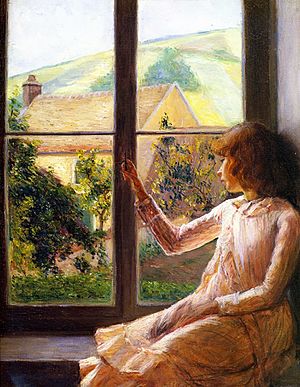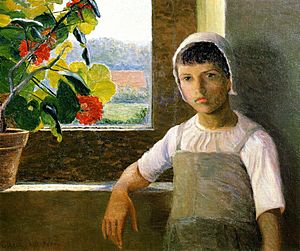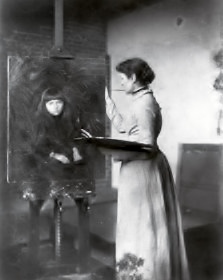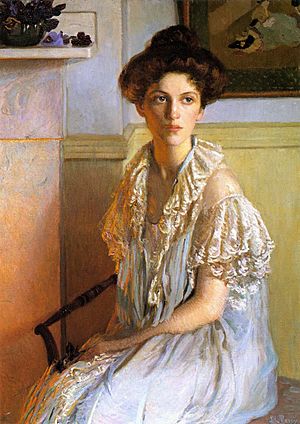Lilla Cabot Perry facts for kids
Quick facts for kids
Lilla Cabot Perry
|
|
|---|---|
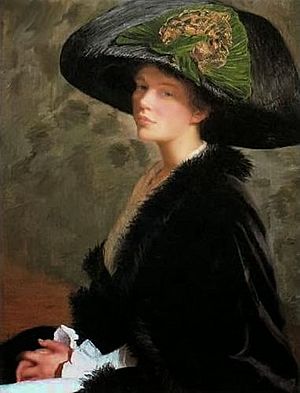
Self portrait, The Green Hat, 1913
|
|
| Born |
Lydia Cabot
January 13, 1848 Boston, Massachusetts, US
|
| Died | February 28, 1933 (aged 85) Hancock, New Hampshire, US
|
| Education |
|
| Known for | Painting |
| Movement | Impressionism |
| Spouse(s) | Thomas Sergeant Perry (m. 1874) |
Lilla Cabot Perry (born Lydia Cabot; January 13, 1848 – February 28, 1933) was an American artist. She painted in the American Impressionist style. This means she used bright colors and loose brushstrokes to capture how light looked at a certain moment. She painted many portraits and landscapes.
Lilla was a big fan of the French Impressionist style early on. She helped bring this new way of painting to the United States. Her early art was shaped by artists from the Boston School and her trips to Europe and Japan. She was also inspired by the ideas of Ralph Waldo Emerson and her friendship with the painter Camille Pissarro. Even though she didn't start formal art training until she was 36, her work was influenced by many art styles, including Impressionism, Realism, and Symbolism.
Contents
Early Life and Family
Lydia (Lilla) Cabot was born on January 13, 1848, in Boston, Massachusetts. Her father, Dr. Samuel Cabot III, was a well-known surgeon. Her mother was Hannah Lowell Jackson Cabot. Lilla was the oldest of eight children. Her brothers included Samuel Cabot IV, who started a company that made stains, and Dr. Arthur Tracy Cabot, a modern surgeon.
Her family was well-known in Boston. They were friends with famous people like Louisa May Alcott and Ralph Waldo Emerson. Lilla's cousin, Mabel, was a close friend. Lilla remembered playing games with Emerson and Alcott. She could also borrow books from the Boston Athenæum library because her father was a member.
Lilla studied literature, languages, poetry, and music. She also enjoyed sketching with her friends. As a child, she loved reading and playing sports outdoors.
When the American Civil War began, Lilla was 13. Her parents were strongly against slavery. They actively helped in the war by caring for wounded soldiers and protecting runaway slaves. When the war ended, Lilla, at 17, moved with her family to a farm in Canton, Massachusetts. This is where her love for painting landscapes and nature began. In 1867, she traveled to Europe with her parents and studied painting there.
Marriage and Family Life
On April 9, 1874, Lilla married Thomas Sergeant Perry. He was a scholar and language expert from Harvard University. His great-uncle was Matthew C. Perry, a famous Commodore in the United States Navy. Lilla and Thomas had three daughters: Margaret (born 1876), Edith (born 1880), and Alice (born 1884).
Art Education and Early Career
Lilla's first known painting, Portrait of an Infant (Margaret Perry), was made between 1877 and 1878. This painting shows a theme she would often return to: her children.
Studying Art in Boston
In 1884, Lilla began her formal art training with portrait painter Alfred Quinton Collins. Collins had studied in Paris. Lilla's painting The Beginner (around 1885–86) was one of her first works under formal guidance. It shows Collins' influence with its serious look, dark background, and strong lighting.
In 1885, Lilla's father passed away. He left her an inheritance, which allowed her to focus more seriously on art. In January 1886, she began studying with Robert Vonnoh, an artist who painted outdoors, a style called en plein air. She also took classes at Cowles Art School in Boston starting in November 1886. Cowles taught "liberal theories" for creating realist art, which Lilla liked very much.
Learning in Paris
Lilla was hired by the Waltham Watch Company to paint their three daughters. She earned enough money to travel first-class to Europe in June 1887. The Perrys moved to Paris that year. Lilla enrolled in the Académie Colarossi, where she worked with Gustave Courtois and Joseph Blanc. She also studied with Felix Borchardt, a German painter.
Besides formal training, Lilla spent a lot of time studying old master paintings in museums with Bernard Berenson, an art critic and her husband's friend. She also went to Spain to copy paintings at the Museo del Prado. Her painting The Red Hat (1888) clearly shows the formal training she received and her study of old masters, especially the work of Sandro Botticelli.
In 1888, Lilla traveled to Munich to study with the German social realist artist Fritz von Uhde. Uhde's way of handling subjects and using color greatly influenced Lilla's work. By the fall of 1888, Lilla was back in Paris. She studied at Académie Julian with Tony Robert-Fleury.
With encouragement from Walter Gay, Lilla sent two paintings to the Société des Artistes Indépendants. Her portraits of her husband, Thomas Sergeant Perry (1889), and her daughter Edith Perry (1889) were accepted. This was a big step for her career in France.
Lilla's success in 1889 led her to be one of the few chosen for Alfred Stevens' class in Paris. Stevens was known for his paintings of "elegant interiors featuring gentle ladies lost in their thoughts." While in Paris, Lilla became friends with Mary Cassatt, Camille Pissarro, and Claude Monet.
A Blossoming Career
Life in Giverny
In 1889, Lilla first saw Claude Monet's work in a gallery. She was so inspired that the Perrys spent the next summer in Giverny, where Monet lived. Lilla wanted to learn more about the Impressionist style. Between 1889 and 1909, Lilla spent nine summers in Giverny. This is where she truly found her artistic voice.
During her time in Giverny, she became close friends with Claude Monet. His Impressionist use of color and light greatly inspired her art. She also worked with other American artists who came to Giverny, like Theodore Robinson and John Leslie Breck.
There's a clear change in Lilla's work after she arrived in Giverny. Her painting La Petite Angèle, II (1888) shows how much her style changed during this time. Unlike her earlier portraits, which used traditional techniques, La Petite Angèle, II is clearly Impressionistic. It has loose brushstrokes that capture the feeling of light and color. Instead of blending every brushstroke, Lilla left the painting "raw." This gave the canvas a lively feel that her earlier works didn't have. Giverny, and especially Claude Monet, inspired Lilla to paint outdoors, use Impressionistic brushstrokes, soft colors, and bright reds. In the window of La Petite Angèle, II, you can see the start of Lilla's love for Impressionist landscapes.
By the fall of 1889, Lilla left Giverny to visit Belgium and the Netherlands. She returned to Boston with her family in 1891, bringing a painting by Monet and some landscapes by John Breck.
Back in Boston
Lilla's art career took on new meaning when she returned to Boston. She didn't just want to paint in her new style. She wanted to "promote a new truth in painting" in the Boston art community, which wasn't very open to Impressionism yet. In 1890, Lilla helped organize the first public exhibition of John Breck's landscapes at the St. Botolph Club.
Lilla won a silver medal in 1892 at an exhibition. In 1893, she was chosen to represent Massachusetts at the World's Columbian Exposition in Chicago, Illinois. Lilla had seven paintings shown there. Four were painted outdoors, and three were more formal studio portraits.
In 1894, Lilla had another success. Her Impressionist paintings were shown in Boston at the St. Botolph Club with other artists. This exhibition showed that Lilla's work was being accepted in America. It also proved that Impressionism was finally gaining acceptance outside of Europe. That same year, she also held an exhibit of Monet's work at the Boston Art Students Association.
Between 1894 and 1897, Lilla's work became known internationally. She exhibited her art in Boston and regularly at the Société Nationale des Beaux-Arts in Paris. In 1897, Lilla had another exhibition at the St. Botolph Club, this time a solo show. A critic from the Boston Evening Transcript said her work was "genuine, no-nonsense, natural." This exhibit showed the range of Lilla's artistic skills, including Impressionist portraits and landscapes.
Adventures in Japan
A new inspiration came into her life in 1897. Her husband got a teaching job in Japan as an English professor at Keio Gijuku University. Lilla Perry met Okakura Kakuzō, who helped start the Imperial Art School. For three years, Lilla lived in Japan and fully enjoyed its unique art scene. In October 1898, Lilla exhibited her work in Tokyo with Kakuzo's help. She became an honorary member of the Nippon Bijutsu-In Art Association.
Lilla's time with Asian art greatly influenced her work. It helped her create a unique style that blended Western and Eastern art traditions. Her paintings Meditation, Child in a Kimono, and Young Girl with an Orange clearly show the changes in her work during her stay in Japan. Unlike her earlier works, these paintings use Eastern subjects. They also show a strong influence from the clean lines of Japanese prints. The mix of East and West is striking. Impressionist portraits flow smoothly with the organized, balanced compositions known in Eastern art. Mount Fuji became the subject of more than 35 paintings, and she made over 80 paintings while in Japan.
Later Years in America and Europe
By 1901, Lilla had returned to Boston. Two years later, they bought a farmhouse in Hancock, New Hampshire, for a summer home. While in Hancock, Lilla painted Boy Fishing (1929), which featured a local farm boy. This painting is now part of the White House Art Collection. In 1904, her Portrait of Mrs. Joseph Clark Grew [Alice Perry] won a bronze medal at a big exhibition in St. Louis.
The next few years were tough for Lilla personally. In 1905, she returned to France, and by that winter, her health was not good. Frequent moves and financial difficulties meant Lilla often needed to paint portraits to support her family. This took a toll on her health.
Return to America Permanently
In 1908, Lilla moved to Boston for good. She focused on portraits because they sold better than landscapes. She got her health back and had six paintings shown in Paris in 1908. In November 1909, Lilla returned to America with new inspiration. The next year, she painted a rare city scene, The State House, Boston (1910). She was a founding member of The Guild of Boston Artists (1914). By 1915, Lilla received another bronze medal at an exhibition in San Francisco for her portrait Hildegarde. In 1916, she painted a portrait of Edwin Arlington Robinson, a poet who often visited the Perrys.
Throughout her career, Lilla was very involved in the art communities wherever she lived. She actively promoted the Impressionist style. In 1913, Lilla helped form the Guild of Boston Artists. She was not happy with the "modern art" trends happening at the time. In 1920, Lilla was recognized for her six years of loyal service to the Guild.
In 1922, she had her first solo exhibition in New York. It included her landscapes from Japan and Giverny. A newspaper review called it "one of the most exciting exhibition given by a woman in this city in years."
Final Years and Legacy

By 1923, Lilla's book of poetry, The Jar of Dreams, was published. It included a poem showing her love for Japan and New England.
That same year, she became very ill. Her daughter Edith also struggled with her mental health and went to a special institution. Lilla spent the next two years recovering in Charleston, South Carolina. During this time, she found new inspiration for landscapes, painting works like Road from Charleston to Savannah. She also found a new theme: "snowscapes," like A Snowy Monday (1926).
In 1927, she had an exhibition. She also published her memories of Claude Monet. The next year, on May 7, 1928, Thomas Sergeant Perry died after being sick. After a time of sadness, Lilla again showed her work at the Guild of Boston Artists in 1929 and 1931. Many of her landscapes were shown, including Autumn Leaves (1926) and Snow, Ice, Mist (1929).
Lilla painted winter scenes, which showed a hint of abstract art, at her vacation home in Hancock, New Hampshire. Mist on the Mountain (1931) was her last landscape shown in an exhibition. She continued to paint until her death.
Lilla Cabot Perry passed away on February 28, 1933. Her ashes, and those of her husband, are buried in Hancock, New Hampshire.
Her Impact on Art
Lilla Cabot Perry's art, which blended Eastern and Western styles, and her beautiful paintings of women and nature, were important contributions to both American and French Impressionism.
She strongly supported the Impressionist movement. This helped other American Impressionists like Mary Cassatt become known and accepted in the United States. She also helped the careers of her friends Claude Monet and John Breck by giving talks about their talent and showing their works. She even worked closely with Camille Pissarro to help him financially by selling his art to her friends and family in America.
Selected Exhibitions
- 1893 – World's Columbian Exposition, Chicago, Illinois
- 1897 – St. Botolph Club in Boston
- 1898 – Tokyo Exhibition
- 1904 – International Louisiana Purchase Exhibition
- 1908 – Salon des Independents, Paris, France
- 1915 – Panama Pacific International Exposition, San Francisco, California
- 1927 – The Gordon Dunthorne Gallery
- 1929 – The Guild of Boston Artists
- 1931 – The Guild of Boston Artists
- 1969 – Lilla Cabot Perry, A Retrospective Exhibition. Currier Gallery of Art, Manchester, New Hampshire
- 1982 – Lilla Cabot Perry, Paintings. Boston Athenaeum, Boston, Massachusetts
- 1989 – The Founders Show, Guild of Boston Artists, Boston, Massachusetts
- 2018 – Women in Paris 1850-1900, traveling exhibition
Selected Paintings
| Work | Image | Date | Collection |
|---|---|---|---|
| Portrait of an Infant (Margaret Perry) | 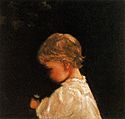 |
1877–1878 | Private collection |
| The Beginner (Margaret with a violin) | 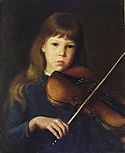 |
1885 | University of Arizona Museum of Art, Tucson, Arizona |
| La Petite Angele, II |  |
1889 | Hirschl & Adler Galleries, Inc. |
| Margaret with a Bonnet (Margaret Perry) |  |
1890 | Private collection |
| Open Air Concert |  |
1890 | Museum of Fine Arts, Boston |
| Self-portrait | 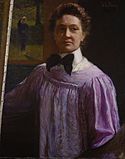 |
1889-1896 | Terra Foundation for American Art, Chicago, Illinois |
| A Stream Beneath Poplars | 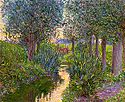 |
c. 1890-1900 | Hunter Museum of American Art, Chattanooga, Tennessee |
| Angela |  |
1891 | High Museum of Art, Atlanta, Georgia |
| Self Portrait |  |
1892 | Hirschl & Adler Galleries, Inc. |
| Portrait of the Baroness von R. | 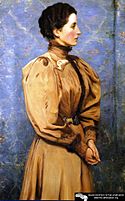 |
1895 | Boston Harbor Hotel, Massachusetts |
| Haystacks, Giverny |  |
1896 | Private collection |
| Portrait of Elsa Tudor | 1898 | National Museum of Women in the Arts, Washington, D.C. | |
| Mount Fuji with Gravestones | 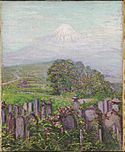 |
1898–1901 | Fogg Art Museum, Harvard University, Cambridge, Massachusetts. |
| The Trio (Alice, Edith, and Margaret Perry) |  |
1898–1900 | Fogg Art Museum, Harvard University, Cambridge, Massachusetts |
| A Cup of Tea | 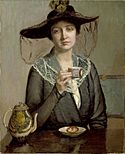 |
Late 19th early 20th century | Los Angeles County Museum of Art, California |
| En barque sur l'Epte à Giverny | 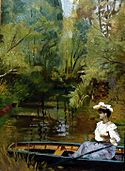 |
by 1900 | Musée Alphonse-Georges-Poulain, Vernon, Eure |
| Lady in Black |  |
1905 | Smithsonian American Art Museum, Washington, D.C. |
| The White Bed Jacket | 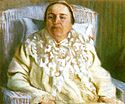 |
1905 | Hirschl and Adler Galleries, New York |
| By the Brook, Giverny, France |  |
1909 | Terra Foundation for American Art, Chicago, Illinois |
| Lady with a Bowl of Violets | 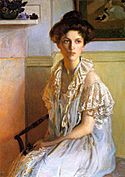 |
1910 | National Museum of Women in the Arts |
| Lady in an Evening Dress (Renee) |  |
1911 | National Museum of Women in the Arts, Washington, D.C. |
| Portrait of William Dean Howells |  |
1912 | Colby College, Waterville, Maine |
| The Black Hat |  |
1914 | Currier Museum of Art, Manchester, New Hampshire |
| Portrait of Edwin Arlington Robinson | 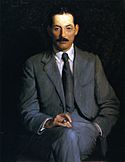 |
1916 | Colby College, Waterville, Maine. |
| A Snowy Monday | 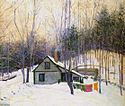 |
1926 | The Cooperage, Hancock, New Hampshire, 1926 |
| Boy Fishing | 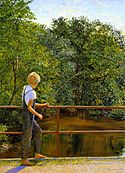 |
1929 | White House, Washington, D.C. |
| Autumn Afternoon, Giverny |  |
undated | Terra Foundation for American Art, Chicago, Illinois |
| The Cellist | 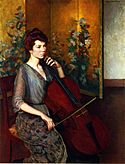 |
undated | Private Collection |
| The Pink Rose | 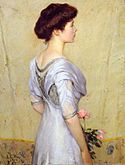 |
undated | Private Collection |
| Reading |  |
undated | |
| At the window |  |
undated | Private Collection |
Publications
- Poetry
- The Heart of the Weed (1887)
- Impressions: A Book of Verse (1898)
- The Jar of Dreams (1923)
- Translation from Greek to English
- From the Garden of Hellas (1891)
See also
 In Spanish: Lilla Cabot Perry para niños
In Spanish: Lilla Cabot Perry para niños
- American Impressionism
- Cabot family



